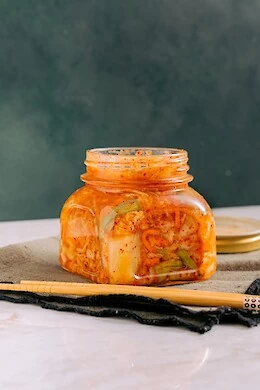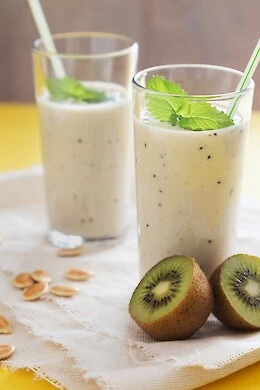Food and Flavour Trends 2024

Recent Posts
Categories
Prepare your taste buds for an adventure as we explore the top food and drink trends for 2024.
From health and wellness ingredients to global cuisine, plant-based innovations and retro delights, 2024 is shaping up to be an exciting year for the food industry. Here are the new food trends to watch out for in the coming year.
- Sustainable food production and waste reduction strategies will gain momentum as consumers become more conscious about their environmental impact.
- Health-boosting ingredients like turmeric, ginger and matcha will continue to dominate as consumers prioritise wellness in their lives.
- Plant-based creations will reach new heights with the incorporation of alternative proteins such as jackfruit, pea protein and mushroom blends.
- Global cuisine will be a major influence, with flavours and ingredients from Africa, South America and the Middle East taking centre stage.
- A resurgence of retro flavours and ingredients will take us back to the "good old days" - with a modern twist.
Focus on Sustainable Food Production
Sustainability is one food trend that is here to stay. Food waste and sustainability have become hot topics in recent years, and this trend is expected to continue. Consumers are seeking ways to make their meals more sustainable with a focus on zero-waste cuisine, meal planning and batch cooking: reducing their carbon footprint. For consumers, reducing food waste goes hand in hand with the drive to save money on food costs against the backdrop of rising interest rates and the cost of living crisis here in the UK.
As consumers become more conscious of the impact of their food choices on the environment, sustainable and eco-friendly options will continue to be in high demand. At Uren, we are committed to sourcing and producing our ingredients in a sustainable and ethical manner, ensuring that we are doing our part in promoting a more sustainable food industry.
What does this mean?
- Nose-to-tail cooking: using the entire animal or plant to reduce waste
- Locally sourced ingredients: reducing carbon footprint and supporting local farmers and producers to do our bit in preventing climate change
- Reusable packaging: discouraging single-use plastics and promoting sustainability in our products
Health and Wellness
The pursuit of a healthier lifestyle has led to a surge in demand for health-conscious ingredients, and 2024 is no exception. This year, expect to see an explosion of turmeric, ginger and matcha-infused products on shelves as their anti-inflammatory and antioxidant properties make them a must-have for health-conscious consumers.
Eating habits are shifting towards a more mindful approach, with a focus on gut health and immunity-boosting ingredients. Look out for ingredients like kimchi, kefir and miso in products as they continue to gain popularity for their probiotic benefits. Drink trends in the wellness sphere will also continue to flourish with the rise of kombucha and adaptogenic drinks.



Turmeric: The Golden Spice
Turmeric, known for its powerful anti-inflammatory and antioxidant properties, will shine in both savoury dishes and beverages. This golden spice adds an earthy, warm, and slightly bitter taste to recipes, perfectly complementing poultry, seafood, and vegetables. It packs an impressive nutritional punch and has many potential health benefits, making it a must-have for those who want to supercharge their meals. For dishes that need a bit of extra colour, turmeric is the perfect choice. Its vibrant yellow-orange hue will brighten up any plate while adding amazing flavour and nutrition.
Ginger: A Versatile Root
Ginger, the spicy root known for its medicinal benefits, will continue to be a key food trend in 2024. In addition to its anti-inflammatory properties, ginger is also known for aiding digestion and relieving nausea. Expect to see this versatile ingredient featured in everything from savoury dishes and baked goods to juices and cocktails.
Matcha: The Green Tea Revolution
Matcha, a finely ground green tea powder, will continue to captivate hearts (and taste buds) with its health benefits and unique flavour profile. Current food trends showcase matcha in everything from lattes and smoothies to baked goods and ice cream. However, the versatility of this ingredient doesn't stop there - keep an eye out for savoury dishes featuring matcha as well. Here are some reasons why matcha is so popular:
- Rich in antioxidants
- It boasts a sweet, grassy taste with a subtle bitterness
- It is found in coffee shops worldwide, offering a delightful alternative to your daily caffeine fix.
With its distinct bright green hue, matcha will continue to be a popular ingredient in drinks and desserts for its flavour and visual appeal.
Floral Flavours: A Blooming Trend
From lavender lattes to rosewater cocktails, expect to see more floral notes in beverages this year. These delicate and fragrant flavours add a touch of elegance and sophistication to any dish or drink, making them a must-try for those looking to elevate their taste experience. Ideas for incorporating floral flavours into your menu:
- Infuse simple syrups with lavender or rose petals to add a subtle floral note to cocktails and mocktails.
- Use edible flowers as a garnish on cakes, cupcakes, or even salads for a pop of colour and flavour.
Global Cuisine
As we embrace the top food trends for 2024, we expect consumer demand for adventurous global fusion cuisine to continue. Consumers are always on the lookout for unique and exotic flavours from different cultures, making it a great opportunity for chefs and food manufacturers to get creative with their menus. Exotic dishes from West Africa, Southeast Asia, and the Philippines are gaining popularity, offering a fusion of flavour and culture in every bite. Some ideas to incorporate global cuisine into your menu:
- Offer a rotating selection of global dishes on your menu, featuring cuisines from different regions to keep customers intrigued and satisfied.
- Use traditional spices and herbs from various cultures in your dishes, such as turmeric, ginger, or lemongrass for an authentic flavour experience.
- Utilise global ingredients like jackfruit, plantains, or yuca in your dishes for a unique twist on familiar favourites.
For more ideas, our Street Food Trends series covers some of the up-and-coming global dishes that we've seen making their way into mainstream menus.



West African Yassa: A Spicy Delight
Originating from the Senegambian region of West Africa, Yassa is a zesty dish that is fast becoming a taste sensation across the globe. This vibrant dish typically features marinated chicken or fish, simmered in a tangy sauce of onions, garlic, mustard, and lemon.
The result is a tantalising blend of sweetness, acidity, and a hint of heat, that pairs wonderfully with fluffy rice or warm, crusty bread. The allure of Yassa lies in its comforting roots, its bold and complex flavours, and its adaptability, which allows it to shine in both traditional and fusion menus. The growing popularity of Yassa reflects a wider trend of consumers seeking out authentic and adventurous flavours from around the world.
Southeast Asian Pandan: The Fragrant Trend
Pandan, a fragrant plant originating from Southeast Asia, is poised to become the next big trend in global cuisine. Known as the 'vanilla of the East', pandan leaves are used widely in Southeast Asian cooking to add a unique sweet and floral flavour to dishes. When used in cooking, the leaves are tied in a knot to infuse broths, rice dishes, and even desserts with a delicate aroma.
In the dessert world, pandan is often paired with coconut, creating a tropical taste that is out of this world. Its vibrant green colour also adds a playful touch to food and beverages. As consumer interest in Asian flavours continues to grow, expect to see more pandan-flavoured offerings on menus across the globe.
Filipino Calamansi: The Citrus Sensation
Calamansi, also known as calamondin, is a citrus sensation that is native to the Philippines. This tiny, tangerine-like fruit is renowned for its intense sourness and remarkable versatility, becoming an indispensable ingredient in Filipino cuisine. The juice of calamansi is a refreshing fusion of lime and tangerine, adding a vibrant citrus burst to marinades, sauces, and beverages.
It's also highly valued for its nutritional benefits, being rich in vitamin C and antioxidants. In addition to its culinary uses, calamansi is also used in household cleaning and skincare products due to its acidity and pleasing aroma. As Filipino cuisine gains recognition on the world stage, the unique tang of calamansi is set to captivate the palates of food enthusiasts worldwide.
Plant-Based Food Trends
Plant-based food innovation has accelerated over the years, and the focus has shifted from processed meat alternatives to more sustainable and nutrient-dense plant-based options.
From jackfruit pulled pork to pea protein burgers, the plant-based trend has taken the world by storm, appealing to vegetarians, vegans, and health-conscious consumers alike. The demand for these products is not just limited to those following a plant-based diet; there's been a significant increase in flexitarianism, where people are consciously reducing their meat intake for various reasons such as environmental concerns and personal health.
These versatile ingredients offer delicious and nutritious options for those seeking to reduce their meat consumption, effectively reducing meat consumption while still enjoying hearty and satisfying meals.



Tempeh: The Protein Powerhouse
Tempeh, a traditional Indonesian soy product, is gaining popularity as a plant-based protein of choice due to its rich texture and versatility. It's made from fermented soybeans and is packed with protein, providing an excellent alternative to meat.
Unlike other soy products, tempeh undergoes a natural fermentation process that increases its nutritional value, particularly its B-vitamin content. Its firm texture and earthy flavour make it a flexible ingredient in various dishes, from stir-fries and salads to sandwiches and stews. As the plant-based trend continues to grow, tempeh is set to rise in prominence, presenting a valuable protein option for vegans, vegetarians, and flexitarians alike.
Jackfruit: The "Meaty" Fruit
Jackfruit, the meaty fruit, is already a popular choice for plant-based alternatives. Packed with nutritional benefits, it's a versatile ingredient that can be used in vegan and vegetarian dishes. With its unique flavour and texture, Jackfruit is great for preparing meals like tacos, burritos, sandwiches, soups, stews and casseroles. Its mild sweetness also makes it a natural choice for desserts and smoothies. It's not just a substitute to meat but also a source of essential vitamins, minerals and antioxidants.
Seitan: "Wheat-Meat"
Seitan, also known as wheat meat, is a high-protein, low-carb food made entirely from gluten, the main protein in wheat. Its dense and chewy texture makes it an appealing meat substitute in a variety of dishes, from stir-fries and curries to burgers and kebabs.
Although it lacks some of the essential amino acids found in animal proteins, pairing it with other plant-based proteins can ensure a complete nutritional profile. One of the advantages of seitan is its neutrality in taste, which allows it to absorb flavours well, making it a versatile ingredient in plant-based cooking. While it might not be suitable for those with gluten intolerance or wheat allergies, for others, it provides a hearty and satisfying alternative to meat.
Fermentation and Gut Health
Food and drink trends are often influenced by the latest health and wellness trends. In the year 2024, there will be a surge in popularity of fermented foods and beverages due to their potential health benefits. Fermented foods are loaded with beneficial bacteria that aid in digestion and promote a healthy gut.



Kombucha: The Fizzy Probiotic
Kombucha, often referred to as the 'fizzy probiotic', is a fermented tea rich in beneficial probiotics. Originating from East Asia, kombucha has become a popular health drink worldwide due to its tangy, effervescent qualities. It's made by adding specific strains of bacteria, yeast, and sugar to black or green tea, and then allowing it to ferment for a week or more.
The result is a beverage packed with a host of potential health benefits, including improved digestion, increased antioxidant activity, and even potential weight loss. However, while kombucha is generally safe for most people, individuals with weakened immune systems should exercise caution due to the potential for harmful microorganisms in homemade versions. This fizzy probiotic drink is more than just a passing trend and is set to make waves in the wellness industry.
Kimchi: The Tangy Superfood
Kimchi is a traditional Korean dish that has gained international recognition for its distinctive flavour profile and health benefits. Primarily composed of fermented cabbage and radishes, seasoned with a mix of chilli, garlic, ginger, and a variety of other spices, kimchi is a rich source of dietary fibre and contains a wealth of probiotics conducive to gut health. It is typically served as a side dish but can also be incorporated into a wide range of dishes to add depth and complexity of flavour.
Kimchi's potent antioxidant properties, largely due to its wealth of vitamin C and beta-carotene, also contribute to its status as a superfood. The high salt content in kimchi acts as a natural preservative, making it an ideal food for long-term storage. However, individuals with high blood pressure or hypertension should be mindful of their intake due to the salt content.
Kefir: The Creamy Cultured Drink
Kefir, a creamy cultured drink, has its origins in the Caucasus Mountains of Russia. This tangy, yogurt-like beverage is created by fermenting milk with kefir grains, which are a unique combination of bacteria and yeast. Kefir is celebrated for its high probiotic content, which aids in digestion and promotes a healthy gut. Additionally, it is an excellent source of protein, calcium, and vitamin B12.
The consumption of Kefir has been associated with numerous health benefits such as improving bone health, fighting bacteria, and potentially reducing the risk of certain cancers. Its rich and creamy texture lends itself well to smoothies and desserts but can also be enjoyed straight from the glass. Like many fermented foods, it should be consumed in moderation due to its potential to cause digestive discomfort in some individuals. Despite this, Kefir remains a versatile and valuable addition to a balanced diet.
Miso: The Savoury Fermented Paste
Miso, a savoury fermented paste, is a staple in Japanese cuisine and has been a part of the country's culinary history for over a thousand years. It is crafted through the fermentation of soybeans with salt and a type of fungus called Aspergillus oryzae, often combined with rice or barley. Miso's culinary applications are incredibly diverse, being a key ingredient in soups, marinades, glazes and even desserts.
From a health perspective, miso is praised for its high levels of protein and rich supply of vitamins and minerals. It is also a significant source of probiotics, which are crucial for maintaining a healthy gut microbiome. Some research suggests that regular consumption of miso can aid in digestion, boost the immune system and even help reduce the risk of certain types of cancers. Miso has a high sodium content, so it should be consumed in moderation and avoided by those with high blood pressure or other health concerns related to salt intake.
Alcohol-Inspired Flavours in Mocktails and Desserts
As people are becoming more health-conscious and looking for alternatives to alcohol, it is expected that in 2024, the global non-alcoholic drinks market will reach a value of USD 987.3 billion. One trend that is gaining popularity in this market is the incorporation of alcohol-inspired flavours in mocktails and desserts. This trend not only appeals to those who are sober or avoiding alcohol, but also provides an opportunity for individuals to enjoy the unique and complex flavours typically associated with alcoholic beverages.
Some examples of alcohol-inspired flavours used in mocktails and desserts include gin and tonic sorbet, espresso martini ice cream, and non-alcoholic spritzers. These flavours are achieved through the use of ingredients such as botanical extracts, fruit juices, and herbs that mimic the taste of their alcoholic counterparts. This trend not only caters to the increasing demand for non-alcoholic options, but also adds a fun and creative twist.
Enduring Food Trend: Retro Flavours
Retro flavours continue to be an enduring food trend, with classic flavours from the 70s and 80s making a comeback in modern cuisine. Vintage flavour offer nostalgic and comforting options for consumers, providing a delightful reminder of simpler times. Some popular retro flavours to look out for include vanilla, butterscotch, peanut butter and caramel. These flavours are being incorporated not only in drinks but also in baked goods, confectionery and even savoury dishes.
Final Thoughts
The food and beverage industry is constantly evolving, with new flavour trends emerging and old ones making a comeback. Whether it's the increasing demand for healthier options or the incorporation of alcohol-inspired flavours in non-alcoholic beverages, these trends are shaping the way we eat and drink. As consumers become more conscious of what they consume, it's important for businesses to stay up-to-date with the latest food and beverage trends in order to cater to their changing preferences.
For over 100 years, Uren Food Group has been at the forefront of flavour and food innovation, providing our partners with high-quality ingredients and consultancy services. We're excited to continue our journey in 2024 and beyond, staying up-to-date with the latest trends and providing delicious solutions for our clients. Here's to a delicious year ahead!










